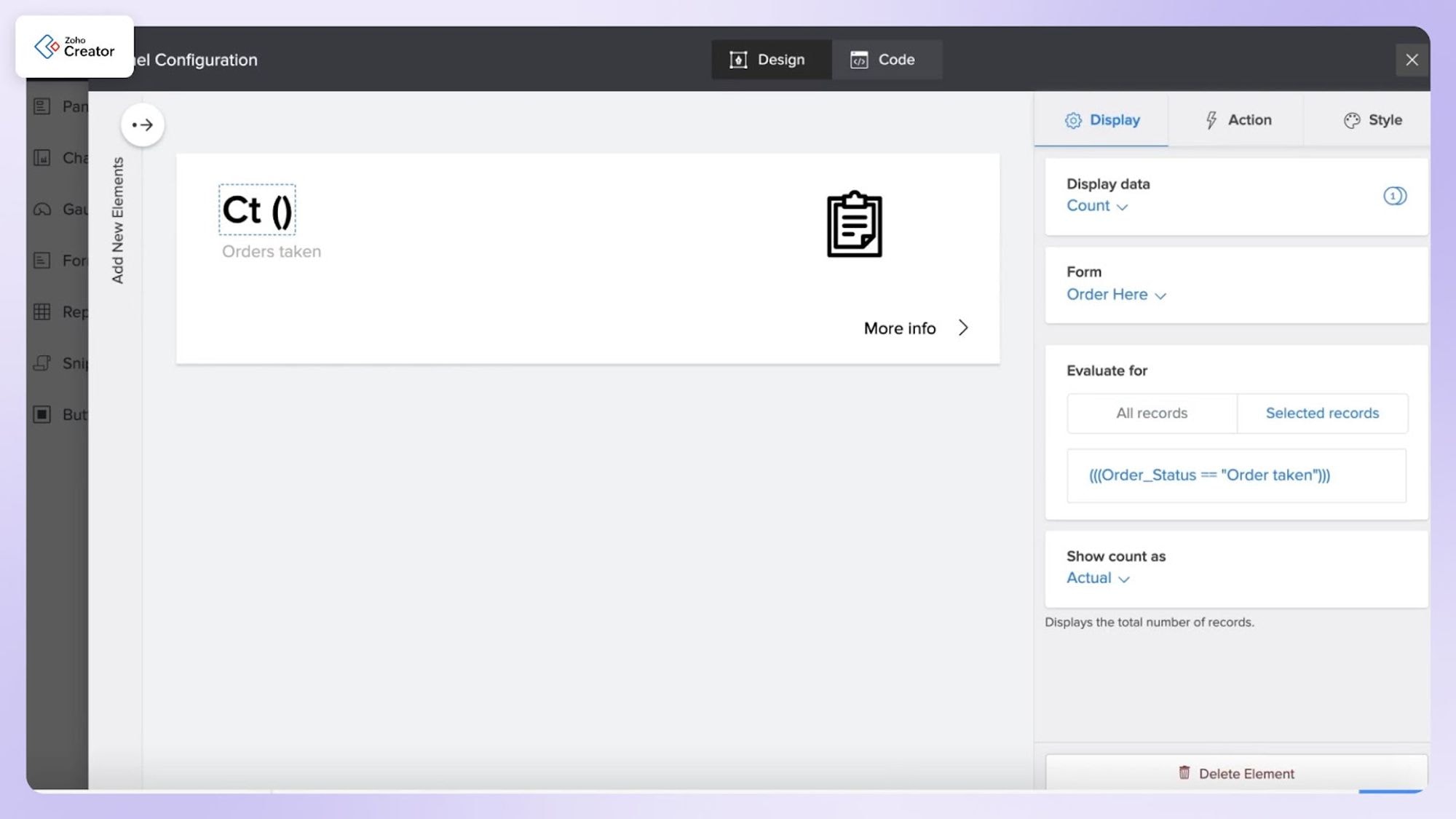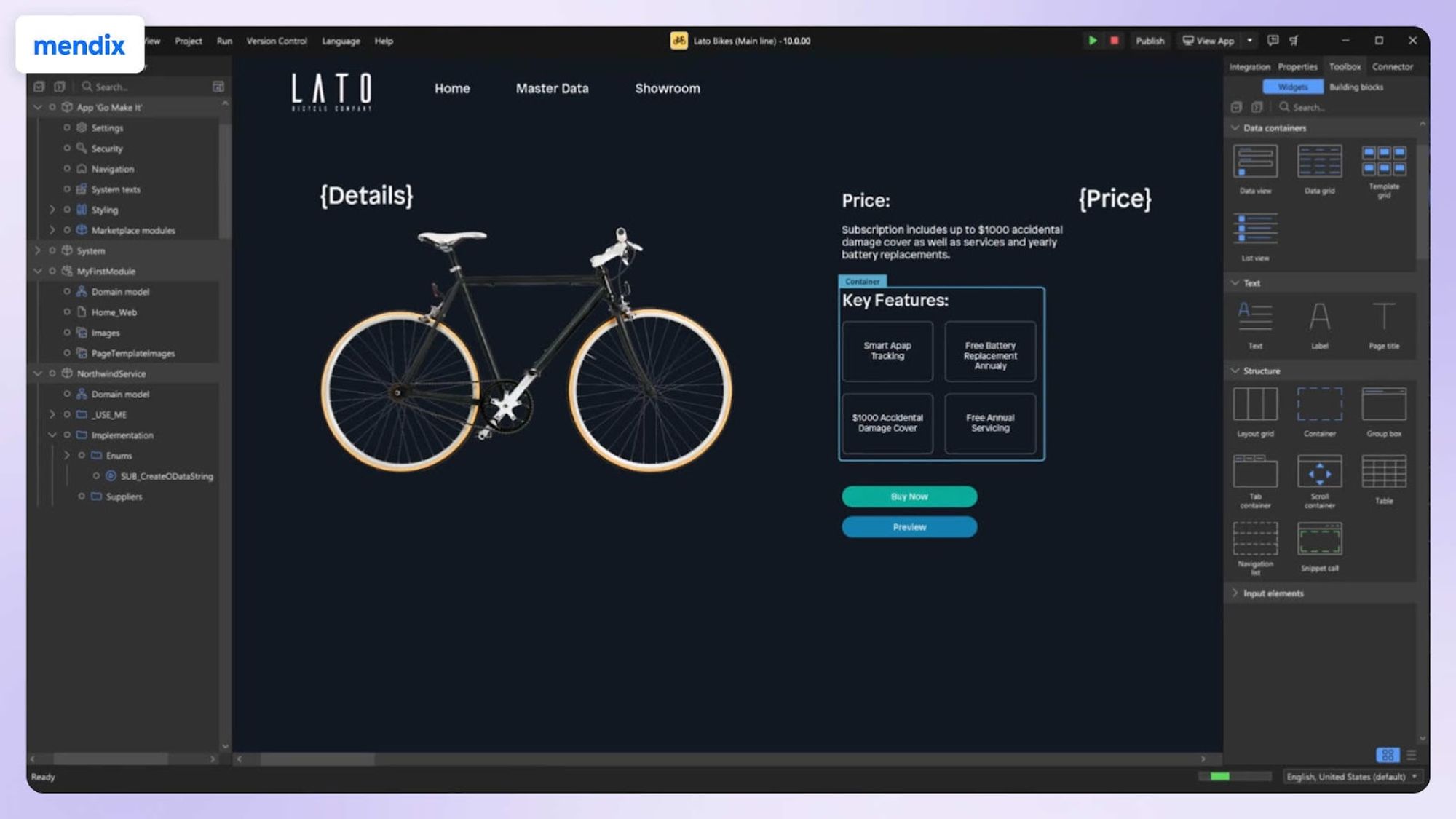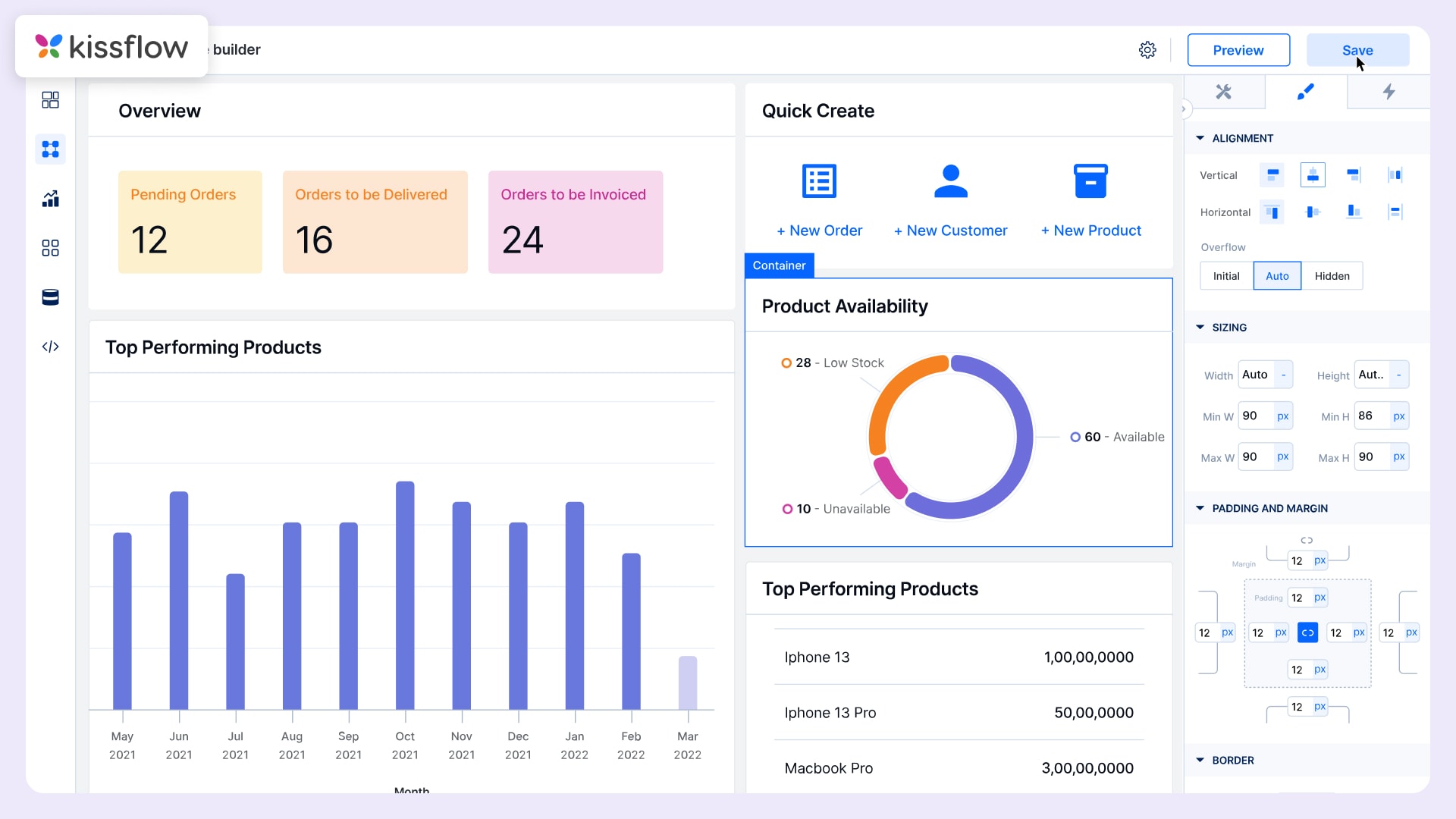Top 10 Power Apps Alternatives and Competitors in 2025


Are you looking for low-code platforms with similar functionality to Microsoft Power Apps but at a lower cost? Or are you interested in open-source solutions to avoid vendor lock-in?
If you need an alternative to Microsoft Power Apps that meets your organization's requirements, you are in the right place.
Microsoft Power Apps is a well-known low-code platform that enables businesses to build internal tools and business applications.
However, you may seek a more cost-effective, faster, and feature-rich platform with no vendor lock-in, better options for code customization, and a shorter learning curve than Power Apps.
The landscape of low-code platforms is vast, and choosing the right tool can be challenging. Let’s look at some of the best Power Apps alternatives.
Why consider alternatives to Microsoft Power Apps?
While Power Apps is exceptional at integrating other Microsoft products, offering low-code platform capabilities, security, scalability, customization, and flexibility, it has some limitations.
These limitations are taken from the users who have given reviews and ratings on reputed platforms like G2, Capterra, and Gartner. Additionally, feedback from customers of Appsmith and other existing users of Power Apps. Here are the limitations of Microsoft Power Apps.
The platform is costlier compared to the standard low-code platforms
The steep learning curve to build and deploy applications
The licensing cost of the premium connectors is complex
There are limited UX and design features to make responsive apps
The limitation of coding editing capabilities restricts complex logic implementation
The platform is proprietary, resulting in vendor lock-in and limits migration in the future
Despite spending a lot of money, you don’t get the expected outcomes from Microsoft Power Apps.
Next, we will learn about the best alternative to Microsoft Power Apps so you can count on every penny you spend purchasing low-code development platforms for your business.
How do we analyze and select these alternatives to Power Apps?
We have thoroughly researched 20 low-code platforms offering better features, security, and connectors than Power Apps to select these competitors.
We have also reviewed reputed app development platforms, such as G2, Capterra, and Gartner, to find the best alternatives to Microsoft Power Apps.
To shortlist the top 10 Microsoft Power Apps alternatives, we analyzed each platform's features, pricing, pros, cons, and integrations. Here are the shortlisted Power Apps alternatives.
Appsmith best for rapid low-code development
Zoho Creator - best for custom app development
Mendix - best for Agile development
Retool - best for internal tools development
OutSystems - best enterprise-grade applications
Airtable - best for no-code workflow management
Quickbase - best for workflow management
Kissflow - best for workflow automation
Caspio - best for database-driven development
Next, check the following table to learn about the alternatives to Power Apps.
Comparison of top 10 Power Apps alternatives and competitors
Power Apps Alternatives | Stand Out Features | Pricing Plans |
|---|---|---|
Appsmith | Open source with no vendor lock-in Usage-based pricing Developer-first product with the ability to write JS code | Free community edition with core functionalities Free plan with key features focused on individual developers and small businesses Business plan starts at $0.4 per hour of usage Provides custom quotes based on requirements |
Zoho Creator | Drag and drop builder with element library and customization | Standard plan starts from $8/user/month Professional plan starts from $20/user/month Enterprise plan starts from $25/user/month |
Mendix | Integrate external AI and in-platform ML | Free edition Standard plan starts from $50/month Premium plan with a custom quote |
Retool | Integrate AI in apps and workflows | Free plan Team plan starts at $12/user/month Business plan starts at $50/user/month Enterprise plan with a custom quote |
OutSystems | Automated completion of logic and workflows with AI | Free plan Developer cloud plan starts at $36,300/year |
Budibase | Visual builder | Free plan The premium plan starts at $50 per app creator/month Enterprise plan with a custom quote |
Airtable | Customizable views | Free plan The team plan starts at $20 per month Business plan starts at $45 per month The enterprise plan comes with a custom quote |
Quickbase | Pipelines designer | The team plan starts at $700 per month for 20 users Business plan starts at $2200 per month for 20 users The enterprise plan comes with a custom quote |
Kissflow | No-code workflow automation | Basic plan with limited features starts at $1500/month Enterprise plan with all features starts comes with a custom quote |
Caspio | Visual application builder | Free plan with limited features Starter plan starts at $50 per month Professional plan starts at $600 per month Enterprise plan starts at $2250 per month. |
Let’s learn about each Power Apps alternative in detail.
Top 10 Microsoft Power Apps competitors & alternatives in detail
Appsmith

Appsmith is an open-source low-code platform that helps organizations build internal business applications like analytics dashboards, database GUIs, customer support tools, and enterprise app extensions. Over 10,000 teams use Appsmith to build tailored internal tools in their organizations.
Founded in 2019, Appsmith has rapidly gained popularity among developers due to its open-source nature, eliminating vendor lock-in concerns. Unlike platforms like Power Apps, Appsmith’s open-source model offers developers better flexibility and control.
GSK, AWS, ByteDance, Dropbox, Tubi, and HeyJobs are Appsmith's top clients. Appsmith enables businesses to scale faster and more efficiently from startups to enterprises by building internal tools on its low-code platform.
Apart from that, Appsmith was added to the Zinnov Zones 2024 report on Intelligent Automation Platforms and Low-Code Application Development, which evaluates and ranks various platforms based on their capabilities, scale, and innovation within the industry.
Being one of the top low-code development platforms, Appsmith offers 18+ native integrations, 45+ customizable widgets, and a built-in JS editor, for building all kinds of applications with minimal coding required.
Appsmith offers multiple integrations, UI customization using JavaScript and CSS, a low-code environment for building diverse applications, and strong community support for continuous improvement and resources.
Sign up for free and start using Appsmith today with usage-based pricing starting at just $0.40 per hour. You can try Appmith on our cloud or self-host in your own infrastructure
Best for: Enterprise, mid-size, and small-scale businesses
Appsmith features better than Power Apps
Get a detailed comparison of the features of Appsmith with Power Apps.
Feature | Appsmith | Microsoft Power Apps |
Drag-and-drop Interface | ✅ | ✅ |
Pre-built Widgets | ✅ | ✅ |
Custom Code Integration | ✅ (Appsmith allows extensive use of JavaScript for custom logic) | ✅ (Power Apps primarily uses Power Fx for custom logic) |
Data Source Integration | ✅ | ✅ |
Version Control | ✅ (Git-based) | ❌ |
Self-Hosting Options | ✅ | ❌ |
Built-in JS Editor | ✅ (An IDE-like editor for writing and managing JavaScript code directly within the platform.) | ❌ |
Custom Widgets | ✅ | ❌ |
Security and Authentication | ✅ | ✅ |
Extensibility with External Libraries | ✅ | ❌ |
Workflow Automation | ✅ | ✅ |
AI Integration | ✅ | ✅ |
Templates | ✅ | ✅ |
CI/CD Integration | ✅ | ❌ |
Knowledge Base and SOP Integration | ✅ | ❌ |
Human-in-the-loop Workflows | ✅ | ❌ |
Intent-based Layouts | ✅ | ❌ |
Appsmith pricing
Appsmith offers three pricing plans: a lifetime free community plan, a business plan that begins at $0.4 per hour of usage and is billed for at least 100 hours each month, and an enterprise version with pricing tailored to the specific use case.
Other key features
Appsmith allows you to sync your repository and dev workflows with Git, import libraries, extend existing apps, secure signups and logins, secure self-hosting, and solid 256-bit encryption.
What do Appsmith users say?
“”“Appsmith is an easy-to-use, flexible tool that provides a fast method for creating functional apps. This tool helps me quickly create interfaces for my SQL backend and even allows me to construct niche use case applications quickly. It is easy to set up and has become a daily tool for many functions company-wide. “ Kessler M. (5/5 Stars)
Build Custom Support Apps 10x Faster with Appsmith
Appsmith is used by top organizations like GSK, Tubi, and Dropbox to develop internal tools like database GUIs, CRUD apps, and analytics dashboards.
Zoho Creator

Trusted by 6 million users, Zoho Creator is a top choice for companies like BharatPe, WhirlPool, Amazon, and BigBasket for designing, developing, and deploying software applications.
Zoho Creator enables business professionals and developers to create and extend applications, such as internal tools, portals, and core systems.
Compared to Microsoft Power Apps, Zoho Creator stands out for its user-friendly interface and ease of use for non-technical users, whereas Power Apps has a steeper learning curve.
While Power Apps integrates with the Microsoft ecosystem (Office 365, Dynamics 365, Azure), Zoho Creator excels with its extensive suite of business applications and competitive pricing.
By building on Zoho Creator, businesses can collect data, automate processes or workflow, analyze data reports, and collaborate with other users.
Pricing: Zoho Creator offers three plans: 1) Standard starts at $8/user/month. 2) Professional starts at $20/user/month. 3) Enterprise starts at $25/user/month.
Key features of Zoho Creator
Graphical user interface: Drag and drop UI elements like buttons, tables, and charts to build custom systems, software, or applications.
Workflow automation: With Zoho Creator apps, collect data, transact payments, update your CRM, and send emails and reports automatically without manual interpretation.
Integration: Zoho Creator allows you to integrate with its different applications to share the same database on all applications like Zoho Invoice, Zoho Reports, Zoho Calendar, Zoho Support, and Zoho Recruit.
Pros of using Zoho Creator
Zoho Creator is an easy-to-use and simple platform that helps create applications quickly with the least technical expertise.
Zoho Creator is easy to integrate and use with various Zoho products, such as Zoho CRM, Zoho Projects, Zoho Invoice, and others, to help you run your entire business under one roof.
Cons of using Zoho Creator
Most users say that Zoho Creator's customer support is relatively bad, as support representatives take 2 to 3 business days to resolve queries.
Zoho Creator is more reliable for creating simple and basic applications; however, creating complex applications requires quite good programming knowledge.
Zoho Creator compared to Power Apps |
|---|
If you compare these two tools, Zoho Creator is easier to set up, use, and administrate. However, Zoho Creator's customer support must be better and more reliable. Power Apps offers a free plan to create applications on the go. Zoho Creator offers different plans that are suitable for small organizations to get started and scale accordingly in the long run. Additionally, Zoho Creator meets the requirements for creating business applications better than Microsoft Power Apps. |
Mendix

Another alternative to Power Apps in our list is Mendix. Mendix is well-known for its AI capabilities and the flexibility it offers users when building software applications. Whether you are looking to drive digital transformation, boost productivity, or streamline the development process, Mendix becomes one one-stop solution for your requirements.
WaFdBank, Toll, Bae Systems, AESSEAL, Fugro, Hydro, and KOC University are top clients of Mendix. AWS, Snowflake, Red Hat, SAP, and Deloitte are top partners of Mendix to drive transformation in your business.
No matter what you’re in, Mendix helps you build applications for financial services, banking, insurance, manufacturing, retail, and the public sector. Mendix offers everything you need to develop applications for your business.
Pricing: Mendix has three plans to match different user requirements. Basic and Standard pricing start from $50 and $800 per month for up to 5 users, respectively. Another plan is Premium, for which you need to get a quote.
Key features of Mendix
Custom code capabilities: Mendix allows you to customize the code of your software application when required.
AI-assistance: Mendix offers AI assistance that becomes your co-developer to help you speed up the design process, avoid errors, and streamline the development work.
Drag-and-drop builder: Create connectors to connect software logic with external systems, widgets to build the UI of your software application, and modules for microflows and user interfaces.
ML kit: The ML Kit allows developers to integrate AI models into applications easily. ML Kit supports ONNX-compatible frameworks like PyTorch and Caffe2 to enable faster integration and reduce the latency of running models with the application’s container.
Pros of using Mendix
Mendix is an easy-to-use and useful tool for building applications that meet your requirements and are scalable for future requirements.
Mendix enables the quick development and deployment of business applications for non-technical developers without programming knowledge.
Cons of using Mendix
For some users, developing complex business applications with coding knowledge is difficult, so you need an IT professional to get your application live.
The pricing offered by Mendix is quite higher than the features and flexibility it provides to create applications.
If you are already using Mendix and looking for better alternatives, we understand you want a platform that has features like Mendix and offers better performance while developing complex apps. Read our comprehensive guide on top alternatives to Mendix to find the most suitable platform for your business.
Mendix compared to Power Apps |
|---|
When comparing these two tools, Mendix is easy to set up and use for all business types. Both tools meet the requirements of the businesses at comparable pricing. However, Mendix offers better features and development roadmaps compared to Power Apps. |
Retool
Retool is a well-recognized low-code platform that helps you build internal software solutions faster. Its top clients include Sensible Weather, Brex, Solera, Westhill, Ramp, Snowflake, Neo4j, and Finn.
Retool caters to the entire market, from startups to Fortune 500 companies worldwide. Utilizing Retool for your internal tool development helps you increase development speed by 10x, reduce development costs, control tool sprawl, and transform application security and compliance.
Get your applications developed on top of and alongside existing systems and SDLC. Retool also helps you modernize your team’s development infrastructure, iterate faster, innovate more, and build ops tooling that matches your stakeholders' requirements.
Key features of Retool
AI integration: Customize and integrate AI into your business workflows, including building custom AI workflows, adding AI actions with any LLM, and automating manual tasks.
Database integration: Connect your application with any databases like Amazon RedShift, BigQuery, Cassandra, CouchDB, and APIs like Firebase, Circle CI, Jira, Sendgrid, and Salesforce.
Drag and drop builder: Get a UI builder that has different components like groups, tabs, lists, buttons, links, and menus to navigate, and trigger queries.
Pricing: Retool offers four plans: A free plan with basic functionalities, business plans starting at $50, Enterprise plans with custom quotes, and Team plans starting at $10.
Pros of using Retool
Retool is suitable for non-technical users due to its simple UI and ease of use, and it requires less programming knowledge to create applications.
Retool connects with all the databases and microservices with a few clicks, making the entire process of building working prototypes, even high-level prototypes, easy and fast.
Cons of using Retool
Some users report that apps built with Retool become less performant when complexity increases and integrating more features delays operations.
Some users have reported that Retool's pricing is higher. This information showcases that Retool is beneficial for enterprise businesses.
“”Overall, Retool is good. However, the tool's performance has become an issue with many users. Otherwise, it is good for building scalable applications. - James S. (4.5/5 stars)
Retool compared to Power Apps |
|---|
If you compare these two low-code tools, Retool meets the business requirements better than Microsoft Power Apps. Retool also has better overall customer support quality and ongoing product support. Retool is also easier to use, administrate, and build applications for all your requirements than Power Apps. The reason is that Retool's customization, templates, and platform compatibility are better. |
Outsystems

OutSystems is another famous low-code platform for building core systems customized to your requirements. It is well-known as an enterprise-grade low-code platform for building complex and business-critical apps to streamline your business.
Toyota, CGI, WesternUnion, Petrobras, and Coppel Access are OutSystems's top clients for speeding up the development process, building a mobile app, and modernizing their digital service infrastructure.
OutSystems is a full-stack low-code platform that offers development, integration, AI, testing & QA, cloud-native architecture, security and governance, DevOps, and ecosystem. Whether you belong to banking & financial services, insurance, government, manufacturing, healthcare, energy and utilities, retail, and education, OutSystems helps to build apps for all industries.
Key features of OutSystems
Drag and drop builder: Create user interfaces by dragging and dropping pre-built UI elements, such as buttons, forms, and data grids, onto the canvas of your application.
Built-in UI framework: Use pre-designed templates and themes to create modern and responsive user interfaces without extensive design.
GenAI integration: Integrate generative AI agents in your applications to improve digital interactions, productivity, and performance using LLMs, RAG, and proprietary data.
Pricing: OutSystems comes with three plans, including free, Standard, and Enterprise, with custom quotes.
Pros of using OutSystems
OutSystems is a complete package of a low-code platform with an easy-to-use interface, integrations, and mobile capabilities for creating applications and automating workflows.
OutSystems is a better tool for building web and mobile applications and applications for particular use cases.
Cons of using OutSystems
Some users say that the OutSystems pricing is quite expensive compared to the features and functionalities offered.
The automated testing feature is helpful but lacks at a certain level and requires improvements, ultimately requiring manual testing.
Are you looking for OutSystems alternatives that offer better UI customization, automated testing, and easy-to-use and learn for citizen developers? Read this detailed guide on top OutSystems alternatives.
OutSystems compared to Power Apps |
|---|
If you compare these two low-code platforms, OutSystems is easier to set up, use, and administer than Power Apps. Reviews on G2 also suggest that OutSystems works better than Power in building business applications. Additionally, users prefer OutSystems in terms of quality and ongoing product support due to its better customer support and updates. |
Budibase

Trusted by 100,000 teams, Budibase is a well-known low-code platform that helps you create powerful apps and workflows. Whether you want to create management apps, portals, approval flows, forms, admin panels, or reports, Budibase helps you with everything.
Above all, Budibase is an open-source app builder that allows you to transform your internal operations while maintaining the security of your own infrastructure. Covanta, Schnellecke, Herrenknecht, and the Bulgarian government are a few of Budibase's clients.
Not only this, Budibase is funded by Signalfire, AngularVentures, and Techstart, which showcases that Budibase is a reliable and powerful tool for building applications and internal tools.
Key features of Budibase
Built-in database: Build and prototype applications that must be managed in an external database. Define data models, create tables, and manage data directly within the Budibase interface.
Drag-and-drop GUI: Simplify drag-and-drop components onto the canvas of your Budibase app layout screen. Auto-generate screens, use pre-built components and add logic to your components to transform data using a JavaScript editor.
Workflow automation: Create multi-step automation with the need for coding. While automating workflows, add condition/logic, schedule your automation, looping, test automation, automation logs, and synchronous automation.
Pricing: Budibase offers small teams, a Premium plan at $50 per app creator per month plus $5 per app user per month, and an Enterprise plan with flexible, volume-based pricing for enhanced control, security, and support.
Pros of using Budibase
Budibase is an easy-to-use tool for creating, customizing, and deploying internal business applications without extensive coding knowledge.
The tool makes it easy to connect with any data source across the enterprise, which saves resources and time in managing to deploy applications.
Cons of using Budibase
While Budibase excels at quickly creating simple to moderately complex applications, it may face challenges when scaling up for more complex and enterprise-level applications.
Despite its user-friendly interface, Budibase can have a steeper learning curve when it comes to advanced customization and integrations.
Budibase compared to Power Apps |
|---|
When you compare these two tools side by side, Budibase is a better option for meeting the business requirements for creating and deploying applications. Due to Budibase's powerful features, Such as the WYSIWYG editor, templates, workflow management, security, and AI integration, It surpasses the Power Apps. |
Airtable

Airtable is a popular low-code platform that combines a spreadsheet's functionality with a database's features and allows the creation of powerful and flexible apps with minimal coding.
From startups to mid-size organizations, the Airtable low-code platform streamlines business operations and improves collaboration. From design to development to customization, Airtable provides everything you require to build apps.
Vimeo, Benchling, BlackRock, and Dropbox Sign are top clients of Airtable for building their internal tools and streamlining their business operations. You can even integrate Airtable with other business-critical tools like Google Drive, Dropbox, Stripe, YouTube, Twilio, and Outlook Calendar.
Key features of Airtable
Integrations: Integrate your Airtable application with other critical applications like Google Drive, Salesforce, Zendesk, Asana, Dropbox, and Evernote.
Automate workflows: Automate processes by creating single- or multi-sequence workflows through trigger and action logic. Extend your logic with JavaScript to expand the functionality of your automation.
Interface designer: Build and share customer interfaces without writing the code of your applications. Drag and drop components, customize interfaces, manage permissions of workflows, and turn data into action.
Pricing: Airtable offers four plans, which include free, team starting at $20/user/month, business starts at $45/user/month, and enterprise comes with custom quotes.
Pros of using Airtable
Airtable is a flexible, easy-to-use, and easy-to-customize tool that helps business members create applications, collaborate, and streamline business operations.
Airtable helps you create and test your ideas by building MVPs quickly without programming knowledge, which allows you to test ideas quickly and save time, costs, and resources.
Cons of using Airtable
Some users say that Airtable's user interface is complex, making it difficult for first-time users to create applications.
As a low-code platform, Airtable does not follow standard development practices like integration with Git as well as offers integration with external DBs.
The learning curve for new users could be daunting for non-technical users, which can be time-consuming for developing applications.
Airtable compared to Power Apps |
|---|
If you compare these two platforms, Airtable is comparatively easier to set up, use, and manage for developing applications to manage spreadsheets compared to Power Apps. Based on G2's review, Airtable is better at meeting business requirements. Apart from that, Airtable's quality and ongoing product support are better than those of Power Apps. |
Quickbase

Quickbase is a popular low-code platform that allows organizations to centralize all data and teams. By building custom applications, you can streamline your business operations and improve productivity.
LEMOINE, Pixelogic, CCI Systems, CLEAResult, and Complex Media are a few of the top organizations using Quickbase for workflow automation and application building.
Quickbase platform supports citizen development, allowing non-technical users to build and maintain applications without extensive coding knowledge. This approach promotes innovation and agility within organizations and allows fast response times and less dependence on IT departments.
Key features of Quickbase
Visual builder: Drag and drop interface for creating applications, forms, and workflows without writing extensive coding.
Database integration: Integrate databases like MySQL, PostgreSQL, or MongoDB to store and manage data and support relational databases.
Workflow automation: Design and automate business processes and workflows to streamline operations. Set up triggers and notifications to automate routine tasks and keep teams informed.
Best for: Enterprise, mid-size, and small-scale businesses.
Pricing: Quickbase offers three core plans: team starting at $700, business starting at $2200, and enterprise with custom quotes.
Pros of using Quickbase
Quickbase is a simple and fast application development without programming knowledge, which saves time, costs, and resources for startups to enterprise organizations.
The QuickBase no-code feature is a game changer. It helps create internal applications like reports, dashboards, and pipelines without needing developers.
Cons of using Quickbase
When extending functionalities for your applications, you need to write your code, which means you should have programming knowledge for customization.
Quickbase compared to Power Apps |
|---|
When comparing these two low-code platforms, Quickbase is easier to use for developing applications and automating workflows and products. Quickbase features like the UI builder, code editor, application templates, and workflows make developing applications easier. |
Kissflow

Kissflow is an enterprise low-code platform that allows IT leaders, developers, process owners, and business users to automate workflows, manage projects, and streamline business processes with minimal coding.
Motorola Solutions, Schnucks, World Vision, and Pepsi are a few top organizations that use Kissflow for digital transformation and improving internal operations by building custom solutions. Kissflow makes it easy for IT teams to clear backlogs faster with its powerful app builder and citizen developers to build tailored apps with minimal coding.
Whether you want high, medium, or low-complexity apps, it helps you with every requirement. It speeds up development, reduces costs, and increases collaboration between non-IT and IT stakeholders.
Key features of Kissflow
Application builder: Get an app builder to design and develop apps using different workflows, boards, integrations, and pages.
Integrations: Connect your application with critical systems such as Asana, Basecamp, Dropbox, Freshbooks, Gmail, Google Drive, and Slack.
Reporting: Generate custom reports using charts, graphs, and metrics according to your requirements. Analyze the reports to get real-time information from the reporting dashboards.
Pricing: Kissflow offers two plans: Basic, starting at $1500/month, and Enterprise, with custom pricing.
Pros of using Kissflow
Create and automate complex workflows with limited technical expertise in HTML, CSS, and JavaScript, eliminating the requirement of professional developers.
Kissflow allows business teams and IT teams to work together to design workflows with zero coding.
Cons of using Kissflow
Some users have pointed out that Kissflow limits high-level workflow customization for complex workflows and limits the flexibility of its templates and components.
Users need to be dependent on new and updated features on Kissflow updates.
Kissflow compared to Power Apps |
|---|
When comparing these two tools, Kissflow is easy to use and can be used to build all applications. However, Microsoft Power Apps is easy to set up, which is its advantage. Kissflow's features, such as the WYSIWYG editor, app templates, workflow management, and data security, are better than those of Power Apps. |
Caspio

Trusted by 15,000 organizations, Caspio is a reliable low-code platform that helps businesses build multi-user apps, workflows, and dashboards with little code. It is known for its point-and-click application builder, designed for non-technical professionals.
Whether you are looking to build reports, custom CRMs, dashboards, knowledge bases, inventory management systems, or bug trackers, Caspio can help you build all types of applications.
No matter in which industry you are in, Caspio helps create tailored solutions and applications that streamline your business operations and processes.
Key features of Caspio
Built-in cloud database: Integrate a cloud database to store and manage data for your applications without the need for coding.
Integration: Connect your applications with third-party systems like Zapier, WordPress, OneDrive, Dropbox, Slack, and Google Drive to ensure their smooth performance.
Drag and drop builder: Create interfaces for your application using different forms, reports, workflows, and components.
Pricing: Caspio has four plans, including free, a Starter plan at $50/user/month, a Professional plan at $600/month, and an Enterprise plan at $2250/month.
Pros of using Caspio
Caspio is a user-friendly app builder that helps build applications without coding, eliminating the need for developers to build internal business apps.
Caspio's customer support team is super helpful in building applications from scratch and providing the proper training to use the platform effectively.
Cons of using Caspio
Some users have noticed that Caspio has a steeper learning curve for making complex and advanced applications, requiring developers to make them live.
The pricing is higher for small businesses compared to the features and flexibility the platform offers for creating internal and business applications.
Caspio compared to Power Apps |
|---|
If you compare Caspio and Power Apps, Caspio is a more reliable and easy-to-use tool for helping businesses with their business application development requirements. Caspio's quality and customer support are better than Power Apps' due to its features and a good customer support team that resolves users' queries. |
Build Enterprise-grade Apps Using Appsmith
Whether you are building AI-powered apps, enterprise app extensions, or customer support apps, Appsmith offers all the capabilities to meet your requirements.
Build your enterprise-level apps 10X faster with Appsmith
In this blog, you have gone through the 10 alternatives of Power Apps on different aspects such as features, pricing, use case, customer support, and customization. A few top alternatives to Power Apps are Appsmith, Mendix, and OutSystems, which you should consider when building internal apps to optimize your business process.
Appsmith is a leading low-code platform that helps businesses develop internal apps such as database GUIs, enterprise app extensions, and customer support apps. Learn more about Appsmith, sign up, and start application development.
Frequently asked questions
1. Which alternatives of Power Apps offer better integrations with existing systems?
Here are the alternatives of Power Apps that offer better integration with existing systems. These alternatives often support APIs, pre-built connectors, and smooth data synchronization capabilities.
Appsmith
Mendix
Appian
Quickbase
Zoho Creator
2. Are there any open-source platforms that can replace Power Apps?
Yes, multiple open-source platforms can replace Power Apps to create simple and complex apps. The key advantages of choosing open-source solutions include no vendor lock-in and full access to code. The open-source platforms that can replace Power Apps are:
Appsmith: An open-source low-code platform that helps businesses create internal applications from scratch.
Budibase: An open-source low-code platform that helps to create business applications, internal tools, and applications.
3. What are cost-effective alternatives to Power Apps for small businesses?
For small businesses looking for cost-effective alternatives to Power Apps, here is a list.
Appsmith
Zoho Creator
Budibase
4. How to choose the right platform for your business
Here are the steps that you can follow to choose the right platform for your business.
Identify your business requirements, goals, and the problems you aim to solve with the platform.
Compare the features of different platforms to learn which one best suits your requirements.
Ensure the platform you choose scales with your business requirements.
Ensure your chosen platform works with your current systems and workflows.
Consider the cost while finalizing the platform for your low-code development requirements.
Related Blog Posts


